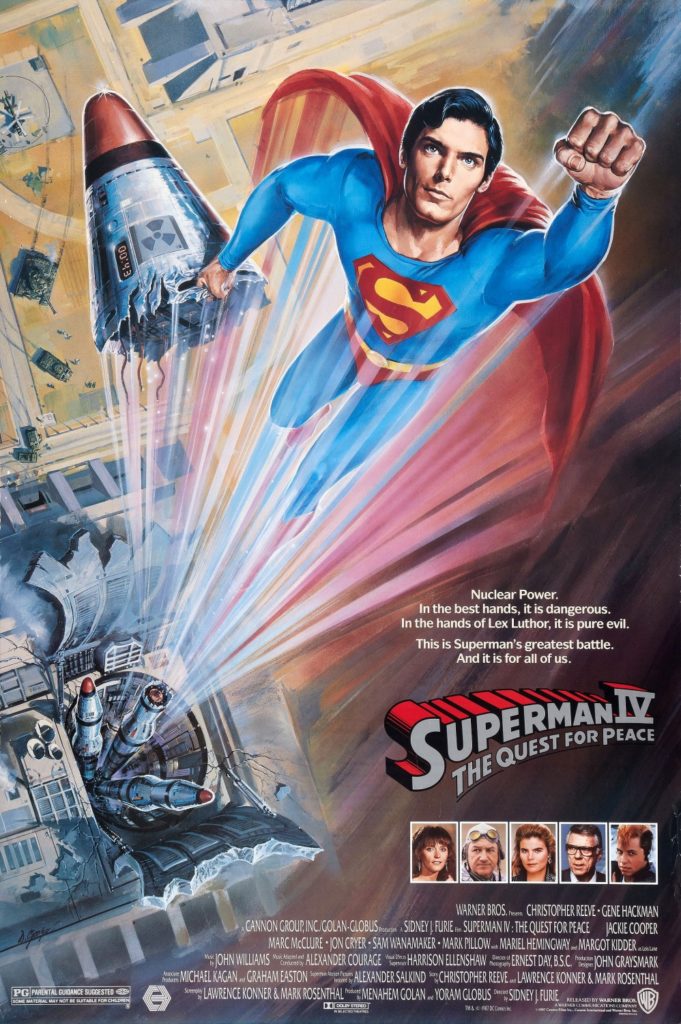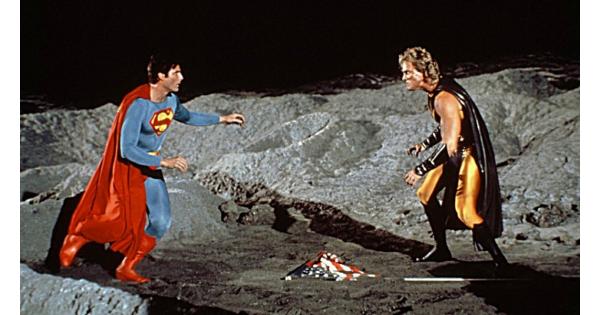So, for reasons I won’t get into here, I wound up watching the 1987 cinematic stinkeroo SUPERMAN IV: THE QUEST FOR PEACE over the weekend, for the first time since I saw it in the theatre upon its original theatrical release 33 years ago. And I have to admit: I didn’t hate it.
I mean, don’t get me wrong. It’s far from good. Light-years from good. But I was surprised to find some things I liked here and there, among the many missteps and missed opportunities. Maybe I’ve become so jaded by the truly bad superhero flicks that have come out in the years since, turkeys like CATWOMAN and FAN4STIC, that this well-intentioned little loser, well, it just can’t get me as angry as it did back in the El Campanil Theatre in 1987.

Written by Lawrence Konner and Mark Rosenthal and directed by Sidney J. Furie, SUPERMAN IV was intended to be a return to greatness after the slapstick nature of the Richard Pryor-fronted SUPERMAN III, but found itself kneecapped by two major flaws: a wildly inconsistent script with a flawed premise at its heart, and a budget slashed so deep it can be seen practically everywhere on screen. Let’s tackle the premise first:
At its core, the film looks to ask the question “Why doesn’t Superman end the Cold War?” And the problem with that is that you should never ask a question if you don’t have an answer for it. Which is what happens here. Superman gets a letter from a kid who asks him to rid the world of nuclear weapons, and he does it. Great. But by the end of the movie, it’s never clear if the world has rearmed itself, or why Superman decides what he did was wrong, just because Luthor used some of his Kryptonian DNA to make up a new villain. (More on that in a bit.) It’s got its heart in the right place, but just limps along to an unsatisfying position at the end.
Along the way, there are glimpses of scenes and moments that could have been great. When Superman goes to speak to the UN Assembly about his plan to rid the world of nukes, there’s a throwaway moment where he needs a sponsor nation to allow him to speak, and every hand from every nation goes up. It’s cute here, but it could have been a really inspirational scene where you see how much Superman means to the entire world, but they just speed by it so fast you barely notice. There’s another farcical scene involving Superman and Lois having a double date with Clark Kent and the Daily Planet’s gorgeous new publisher Lacy Warfield (played with surprising appeal by Mariel Hemingway). Again, here it’s only played for laughs, but you get a hint of a really interesting dynamic that we rarely got to see: Just as Lois only has eyes for Superman, Lacey is only interested in Clark Kent and doesn’t much care about the Man of Steel. A more nuanced scene that played those two relationships off each other might have been great, but we only get hints of it here. The script even does a good job of introducing Lacey as little more than a shallow vamp, and developing her into a sympathetic character who doesn’t seem out of place palling around with Lois Lane. (And one who treats Clark Kent better than Lois ever did.)
Speaking of Superman and Lois, the film’s biggest sin comes about half an hour in, when Superman reveals his secret identity to Lois again, just so they can re-enact their flying romance scene from the original film, then takes away her memory of it again with another super-hypno-kiss, which is apparently still a thing. It just feels like an empty play on the audience’s nostalgia, and winds up making Superman look really creepy, which is never what you should be going for.
There are other big flaws in the film too, not the least of which is the invented villain cooked up by Gene Hackman’s Lex Luthor: Nuclear Man, who looks like a Venice Beach bodybuilder and doesn’t even get to say his own lines, with Hackman’s voice overdubbed instead. Why this wasn’t Bizarro instead of the uninspired empty suit we were given still eludes me. Lots of folks complain about the inclusion of Jon Cryer as Lex’s teenage cousin Lenny Luthor, but really, he’s no more annoying a sidekick than Ned Beatty’s Otis, and he’s barely in the movie anyway.
The biggest problem is just the budget, or rather, the lack of one. You can see it everywhere, most glaringly in the horrible visual effects. Superman’s flying has never looked more fake, compared to the seamless flight sequences in the original, which hold up well even today. But it’s not just the effects: to save money most of the film was shot in the UK, in a village called Milton Keynes, which was at the time sporting some of the most modern architecture in the UK, but certainly looked nothing like Metropolis. Even the costumes and makeup are below par, with poor Margot Kidder in particular wearing some of the most atrocious outfits I’ve ever seen on screen.
So with all this to complain about, why did I say I found myself enjoying it more this time? Well… I don’t know, I just did. All the actors are doing the best they can with the poor material and surroundings they’ve been given, and there’s still a sincerity about it that I haven’t found in any of the SUPERMAN movies since. The original film promised us “You’ll believe a man can fly,” and I did. I didn’t believe it here, but I at least believed that the actors believed it, and I guess that was enough.


Comments are closed.